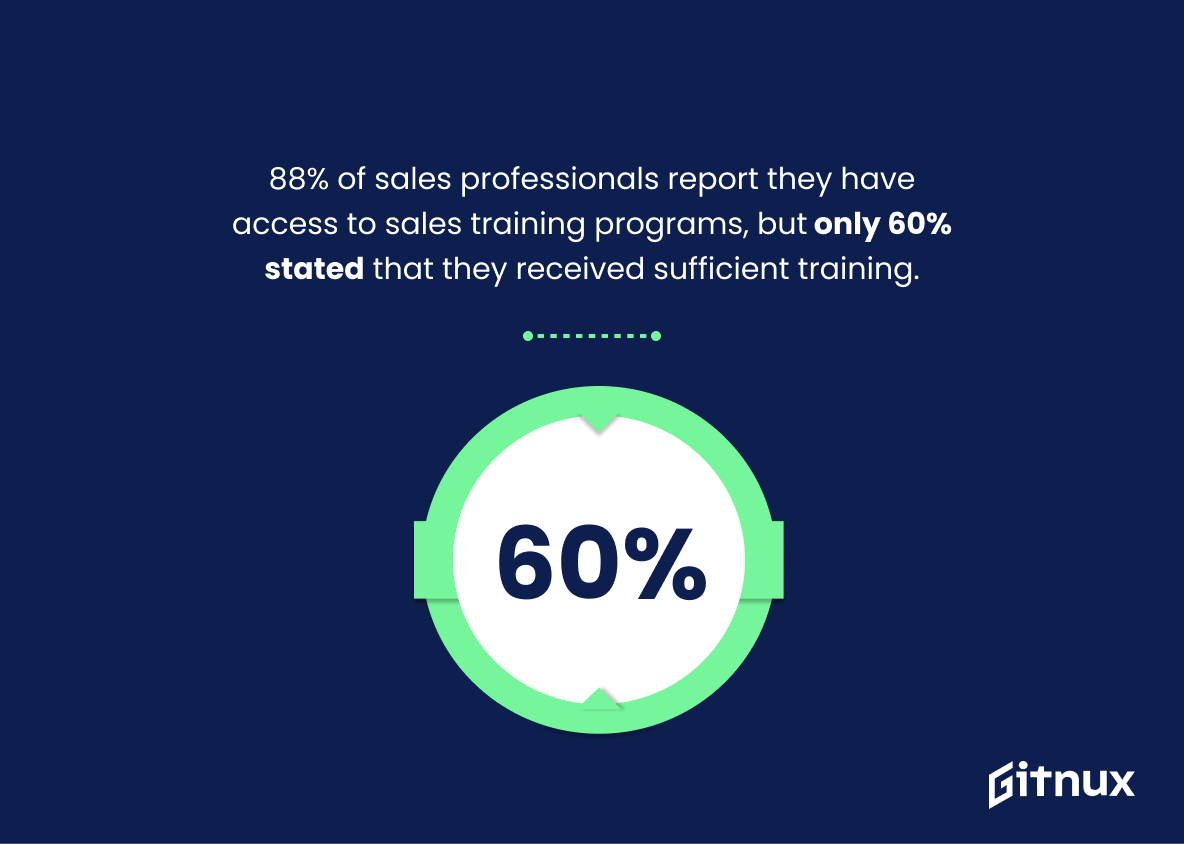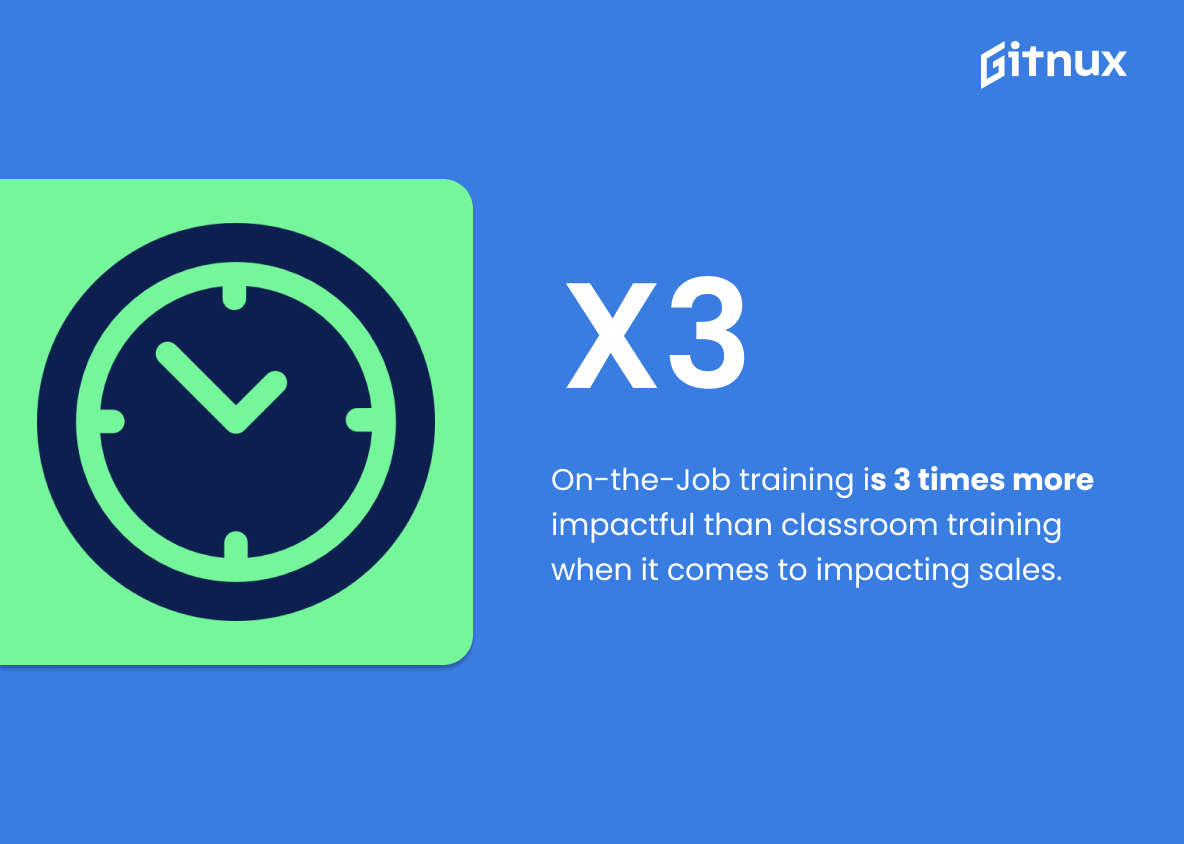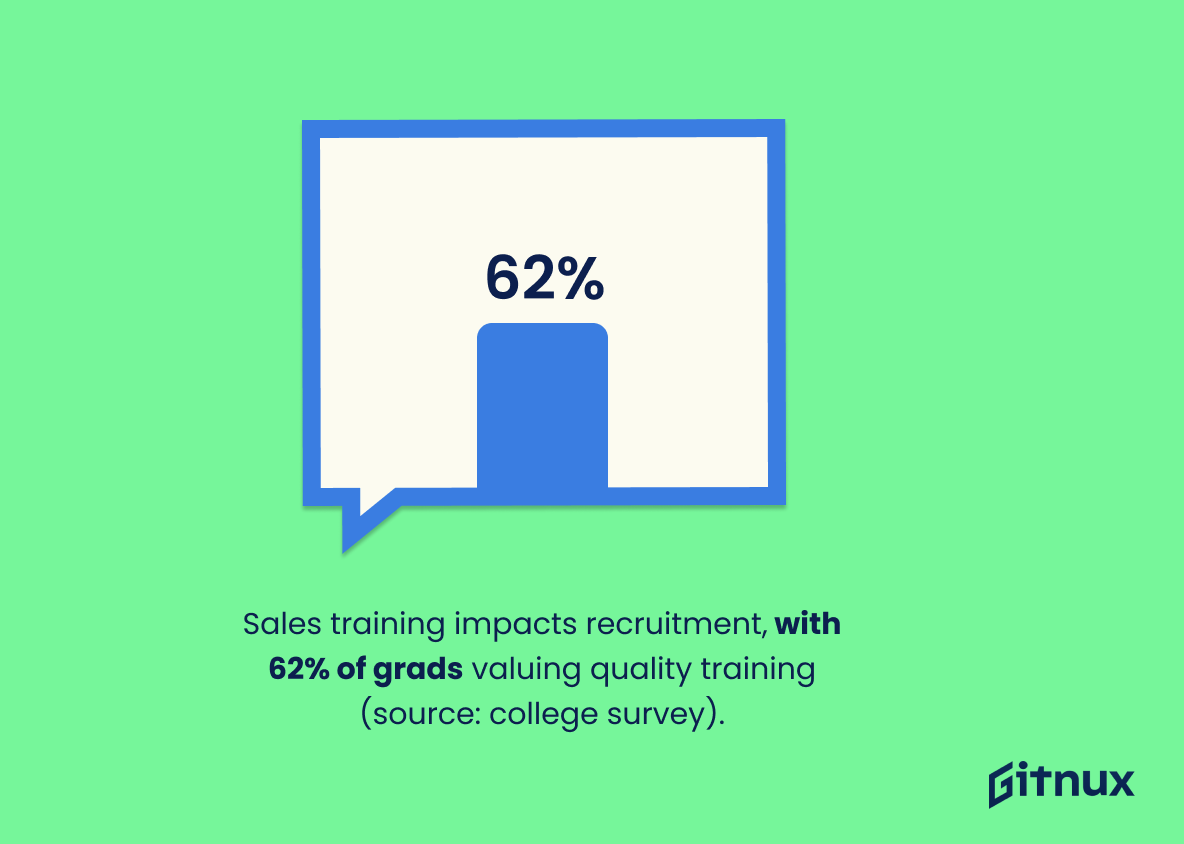In the dynamically evolving world of sales, training is not just a necessity, it is an ongoing process which defines the success of an organization. The very essence of sales hinges upon effective communication and relationship building skills, something that cannot be mastered without comprehensive training. Many businesses, however, are still skeptical about the value and return on investment of sales training.
This blog post aims to dispel any such doubts by showcasing the power and performance of well-trained sales teams through the lens of thought-provoking and persuasive sales training statistics. Glean insights into the essential role that sales training plays in boosting conversion rates, elevating customer satisfaction and driving business growth. Let’s delve into the numbers that underline the importance of investing in sales training.
The Latest Sales Training Statistics Unveiled
About 55% of salespeople lack basic sales skills according to studies.
Unveiling a shocking revelation, studies disclose that roughly 55% of salespeople are operating without the necessary fundamental skills. Imagine, over half of our selling warriors venturing into the battleground ill-equipped. It’s akin to playing a championship game with an untrained majority; quite the gamble, isn’t it? This statistic turns a spotlight to the absolute need for adequate sales training.
Within our blog post about Sales Training Statistics, this highlights the essentiality and potential impact of comprehensive training programs in arming over half of the sales force with winning strategies and tactics. It underscores the immense potential lying untapped in over 50% of the salespeople that can be unlocked with proper training, catapulting sales to towering heights.
Only 29% of people want to speak to a salesperson to learn more about a product, while 62% will consult a search engine.
From an innovative perspective, this statistic sheds revealing light on the shifting dynamics of the sales landscape. The 29% share of people leaning towards interactions with salespersons reflects a seismic shift in information gathering behavior. Direct product knowledge, which was once solely the territory of salespeople, is now increasingly sought from search engines by 62% of consumers.
This calls for a re-imagination of the focus and content of sales training programs. The emphasis should be on harnessing the power of digital technology and SEO to capture the attention of this majority while maintaining the fundamental elements of human interaction to win over the 29%. Ultimately, this statistic serves as a compass, steering the direction of the evolving sales training module.
77% of learning professionals think that personalized learning is vital for employee engagement.
Diving into this riveting statistic paints a vivid picture of the critical role personalized learning plays within a workforce. In the world of sales, constant training is paramount for success. It’s compelling to note that a significant 77% of learning professionals underscore the indispensability of customizable education for employee engagement.
Reflecting on sales training, one can certainly see how this nugget of information shines brightly. Tailored training aligns employees’ strengths, weaknesses, and unique sales techniques with the company’s goals – which could translate into higher sales performance.
Cast even more dramatically in the spotlight, personalized learning forms the backbone of effective employee engagement. An engaged employee is passionate, dedicated, and likely to perform better- all qualities desired in a sales representative. More engaged sales reps can lead to increased customer satisfaction and company profitability. Overall, this statistic pulses at the heart of a successful sales training program, underscoring just how instrumental personalized learning is in driving engagement and, ultimately, sale outcomes.
According to a research by Sales Performance International, sales training can improve salesperson’s performance by up to 20%.
Elevating the curtain on the transformative potential of sales training, a study by Sales Performance International reveals an exciting prospect. Imagining a salesperson’s performance bolstered by a staggering 20%, can feel akin to unlocking hidden superpowers. This gem of a statistic dramatically underscores the value of sales training.
In the pulsating heart of a blog post about Sales Training Statistics, it serves as a compelling beacon of promise, gauging not only the significance of ongoing personal development, but also the untapped performance potential that professional training can uncork. The 20% uplift serves as tangible evidence that investment in sales training goes beyond cliched concepts of ‘knowledge expansion’, ‘skill enhancement’, truly manifesting as concrete performance progression.
88% of sales professionals report they have access to sales training programs, but only 60% stated that they received sufficient training.
Shining a spotlight onto the intriguing disconnect in the world of sales training, these striking statistics reveal an intriguing conundrum. With a commanding majority of 88% of sales professionals affirming access to sales training programs, one might reasonably predict an equivalent level of reported satisfaction. Yet, the reality, as per the figures, paints a different picture – a significant 28% gap where only 60% assert that they’re receiving adequate training.
In the vivid tapestry of sales training statistics, these figures arouse intrigue by uncovering a potential quality or contentment chasm. For advocates of sales training – and those passionate about optimising their performance – these numbers serve as a pivotal wake-up call. They might ignite critical discussions about the quality and content of the sales training programs available, focusing particularly on making them sufficient, relevant, and effective for every sales professional’s needs.
On-the-Job training is 3 times more impactful than classroom training when it comes to impacting sales.
Delving into the realm of sales training statistics, we uncover a dazzling gem: On-the-job training holds a powerful influence that swells to three times the impact of traditional classroom training on sales. This statistic paints in brilliant hues the immense potential fueling on-the-job training in turbocharging sales outcomes.
It gratifies and incites wonder, implying the inherent value of real-time, hands-on experiences in sharpening sales acumen and transforming them into palpable results. Injecting this insight into the lifeblood of a blog post serves to inspire reform in sales training tactics, accelerating approach towards a more practical, experience-based model, unlocking untapped potency and ushering in the era of supercharged sales performance.
Sales training has a large influence on recruitment and retention, where 62% of college graduates prioritize opportunities with quality training.
Shedding light on the relevance of this statistic, it beautifully underscores the power that quality sales training wields in attracting and retaining top talents. Specifically, it is compelling for employers to know that a staggering 62% of college graduates place high importance on superior training opportunities during job selection.
Thus, this statistic can be the catalyst that propels businesses to invest more in their training programs, recognizing that this investment can directly influence their recruitment success and talent retention rates. And not to forget, a well-trained sales team is often the magic wand that multiplies profitability. So, in the whirlwind of figures and facts, this statistic emerges as a key driver in the ongoing dialogue regarding sales training’s undeniable value.
The average large company spends $189,000 on sales training annually.
Examining a figure as revealing as large companies expending $189,000 annually on sales training frames the conversation in a new light. It highlights the gravity large corporations place on sales skill enhancement, showcasing the intensity of the competitive sales landscape.
This number speaks volumes about not just that the sales training is seen as a crucial investment, but also that keeping sales staffing well-trained is a critical factor in fueling business growth and profitability. It underscores the need for all businesses, regardless of size, to engage in sales training if they hope to remain viable in the competitive market.
59% of salespeople say that they find their CRM tool difficult to use, emphasizing the need for proper sales training.
In weaving the tapestry of effective sales training, the threads of technology usage form a significant part. Imagine, amidst all the hi-tech tools pitched their way, a staggering 59% of salespeople find their CRM tool confounding. This underlines the scope for enhancement in tech-savviness. Sales training with an emphasis on embracing and mastering technological applications like CRM then, is not just a nice-to-have, but a dire necessity, integral to ensuring that the benefits of such tools are fully capitalized.
74% of companies who weren’t exceeding revenue goals did not know their visitor, lead, MQL, or sales opportunities.
Let’s take a trip in the corporate world, specifically dabble into the department that defines a business – yes, you got it right, the Sales department. Now, imagine this quite intriguing landscape where an astonishing 74% of corporations hovering below their revenue goals had a blank face when asked about their visitor demographics, lead numbers, Marketing Qualified Leads (MQLs), or even their potential sales opportunities. Shocking, isn’t it?
Take this statistic as the protagonist of your attention in the context of a blog post about Sales Training Statistics. It serves as a loud wake-up call emphasizing the crucial need for better sales training and strategic education. Businesses can’t be flying blind; they need to know their key metrics. Without this knowledge, they’re essentially driving without a map, unsure of their direction, which as shown, can be catastrophic for reaching revenue goals.
Being unaware of the value of their potential leads and opportunities is akin to leaving money on the table for these otherwise promising companies. Therefore, thorough sales training is not a luxury but an absolute necessity for meeting, and even exceeding, planned revenue targets. This eye-opening statistic, hence, emphasizes the dire need for more effective sales training programs.
The average company spends $24,000 annually on training their sales reps, with a 69% that focuses on processes, methodologies, and skills.
In the kaleidoscope of Sales Training Statistics lies a brilliant gem: the average company fritters away $24,000 annually on coaching their sales rep stars. This mammoth share of the training budget illuminates how businesses budget for the battlefield of sales, sharpening the ammunition of processes, methodologies, and skills that make up a whopping 69% of this training treasure chest.
This robust evidence paints a vibrant illustration of how much value businesses place on developing proficient sales professionals and how the distilling of aptitudes is perceived as a key investment in driving business victory. So, all set to dive into this oceans-deep statistic and discover how these numbers can help shape a formidable sales force?
As per a Sales Performance International study, over one-third of the respondents witnessed selling skills significantly impacted by sales training programs.
The significance of the aforementioned statistic from the Sales Performance International study becomes vividly apparent in the context of a blog post about Sales Training Statistics. It underlines the potential power of sales training programs, emphasizing the direct influence they have in enhancing selling skills. Over one-third of respondents witnessing a significant impact underscores the not-to-be-underestimated value these programs bring.
In the fiercely competitive world of sales, this statistic serves as a tangible reminder of the hidden arsenal in continuous training, turning the spotlight on the potential for individuals and businesses to elevate their sales game, adding a touch of empirical credibility to the narrative.
Companies that spent over $1,500 per employee annually on training had gross profit margins 24 percent higher than those that spent less.
Unveiling the rich tapestry of the realm of sales training statistics, this data point sheds light on a compelling business narrative. It demonstrates the significant economic advantage reaped by companies which fuel their operational engines with a robust investment in employee training. By splurging over $1500 per employee on annual training, a commendable surge has been recorded in their gross profit margin – an increase by an impressive 24%.
This underscores the bond between skill enhancement and profitability. In essence, the data point unveils that the power of knowledge can render tangible dividends in the business landscape, a testament to the timeless adage “Knowledge is Power”. Investing in the intellectual capital of a company doesn’t just facilitate a more skilled workforce, it paves the way for a steeper profit trajectory, clearly aligning with the core objective of any business venture – maximising profitability.
Conclusion
In the ever-changing landscape of sales, having a well-trained team is not just a bonus, but a necessity. These sales training statistics demonstrate just how much that training can impact growth, employee retention, efficiency, and ultimately, bottom line profits.
By investing in ongoing, high-quality sales training, businesses can equip their teams with the skills and knowledge necessary to navigate complex sales processes, understand and respond to customer needs, and drive company performance. The crucial role of effective sales training cannot be overstated, and these statistics highlight the rich value it holds for any sales-driven organization.
References
0. – https://www.elearningindustry.com
1. – https://www.spisales.com
2. – https://www.business.linkedin.com
3. – https://www.blog.hubspot.com
4. – https://www.www.salesforce.com
5. – https://www.www.hubspot.com
6. – https://www.www.reallysimplesystems.com
7. – https://www.www.mavenwave.com
8. – https://www.financesonline.com
9. – https://www.www.mckinsey.com










